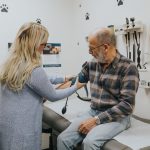Under Review: No
Issued by Council Jan. 1, 2010 (After-Hours Access to Care and Preventing Follow-up Care Failures)
Reissued by Council : Apr. 1, 2022; June 1, 2015 (Continuity of Care)
Note: a glossary of terms can be found at the end of this document. Glossary terms are indicated in teal with a “G” throughout this document.
PREAMBLE
All regulated members have a professional and ethical obligation to ensure continuity of care for their patients. Regulated members are expected to use their professional judgment to determine how best to do this while acting in good faith to facilitate access to coordinated care.
Patients who receive greater continuity of care have better health outcomes, higher satisfaction rates and the care they receive is more cost effective. Continuity of care is achieved in two principal ways:
- Through a continuous caring relationship with an identified health care professional; and
- Through a seamlessly integrated service (e.g., team-based careG) enabled by the coordination and sharing of information between different providers.
Continuity of care does not mean individual regulated members need to personally be available at all times to provide continuous access or on-demand care to patients. Doing so would compromise the health of regulated members and negatively impact the quality of care provided to patients.
To facilitate continuity of care and minimize risks to patient safety, CPSA has set out expectations for regulated members, recognizing their role in facilitating continuity of care includes being available and responsive to patients’ needs, promoting the seamless integration of care within accountable multidisciplinary teams, including the sharing of necessary information to assure quality patient care, and ensuring patients are provided with information on how to access care when their physicians are unavailable.
STANDARD
1.A regulated member who orders an investigation must:
-
- explain the reason and implication(s) of the investigation to the patient and document the discussion in the patient’s record, in accordance with the Patient Record Content standard of practice;
- for patients who have a risk of receiving a clinically significant investigation resultG, have a system in place to track results when they are not received when expected1;
- review investigation results and consultation reports in a timely mannerG;
- arrange and notify the patient of any necessary follow-up care;
- document all contacts with the patient, including failed attempts to notify them about follow-up care, in accordance with the Patient Record Content standard of practice;
- directly provide or arrange for continuous after-hours care through an appropriate healthcare provider(s) and/or serviceG with capacity to assess and triage care needs;
- ensure handover of relevant patient informationG to the after-hours healthcare provider(s) or service when the patient’s need for after-hours care is reasonably foreseeableG;
- ensure patients are provided with information on how to access care after hours; and
- if using a recorded message to direct patients to a healthcare provider or service, have evidence of an agreementG with the identified healthcare provider or service.
2. A regulated member who participates in a team-based careG environment must assure processes and procedures are in place that ensure safe care of patients, including:
-
- a process for team-based review of investigation results and consultation reports;
- a process for the timely sharing of patient health information with other providers to support quality patient care; and
- clear processes within the team for timely follow up.
3. A regulated member, including those involved in a team-based careG environment, who copies another healthcare provider (e.g., when requesting an investigation, providing treatment requiring follow-up, etc.) remains responsible for any necessary follow-up care unless the healthcare provider/team to whom the copy is directed formally agrees to accept responsibility for follow-up care.
4. Where another healthcare provider agrees (see “Evidence of an agreement” in glossary) to accept responsibility for follow-up care, the regulated member must ensure handover is done in accordance with the Transfer of Care standard of practice.
5. A regulated member who receives an investigation result in error (e.g., same or similar name or contact information) must inform the laboratory or diagnostic facility of the error in a timely manner.
6. A regulated member must have a process in place for receiving and responding to critical investigation resultsG reported by a laboratory or imaging facility after regular working hours or in the regulated member’s absence2.
7. A regulated member who will be unavailable during temporary absences must:
-
- enter into an agreement (see “Evidence of an agreement” in glossary) with an appropriate healthcare provider and/or service to provide ongoing care during periods of unavailability, ensuring handover at the start and conclusion of the coverage, including management of:
-
- outstanding investigations and investigation results;
- outstanding referrals and consultation reports; and
- any follow-up care required as a result of the above;
-
- have a plan or coverage in place that allows other healthcare providers to communicate or request information pertaining to patients under their care during a temporary absenceG; and
- inform a patient of ongoing care arrangements where they would have a reasonable expectationG of being informed.
- enter into an agreement (see “Evidence of an agreement” in glossary) with an appropriate healthcare provider and/or service to provide ongoing care during periods of unavailability, ensuring handover at the start and conclusion of the coverage, including management of:
8. A regulated member must not charge patients for insured after-hours access.
9. A regulated member must not order a diagnostic test or make a referral request in another healthcare provider’s name.
10. Notwithstanding clause (9), the regulated member may order a diagnostic test or make a referral in another healthcare provider’s name in certain circumstances, if they carbon-copy (“CC”) themselves and there is evidence of an agreementG, including, but not limited to:
-
- providing locum coverage;
- assignment of a post-graduate training program participant to a service; or
- practising in a team-based careG environment, in accordance with clause (2).
GLOSSARY
Clinically significant investigation result: a test result determined by a reasonable physician to be one which requires follow-up in a timely fashion, urgently if necessary. Physicians determine the clinical significance of a test result using their clinical judgment and knowledge of the patient’s symptoms, previous test results, and/or diagnosis1.
Critical investigation results: results of such a serious nature that immediate patient management decisions may be required1.
Evidence of an agreement: documentation in which the healthcare provider or service agrees to accept responsibility for follow-up care (e.g., an email).
Reasonable expectation: typically in established physician-patient relationships where a patient would see the regulated member during their absence. Can also include patients awaiting investigation results.
Reasonably foreseeable: the likelihood the patient will experience issues, adverse effects, etc. in the context of that particular patient’s health care.
Relevant patient information: pertinent clinical information including, but not limited to, the patient’s name and contact information, the regulated member’s contact information (in the event of an emergency), relevant/outstanding investigations, treatment plans/recommendations, etc.
[Appropriate] service: for the purposes of this standard, “service” includes, but is not limited to, Health Link, an emergency service, after-hours medical clinics. Evidence of an agreement with an appropriate service is required.
Team-based care3: the provision of health programs and services by two or more healthcare providers who work collaboratively with patients and their circle of care to deliver coordinated, high-quality health service. For the purpose of this standard, team-based care requires processes outlining clear expectations for each team member’s responsibilities and accountabilities.
Temporary absence: vacations and leaves of absence (e.g., parental leave, educational leave), as well as unplanned absences due to, for example, illness or family emergencies. This does not include suspensions of a physician’s certificate of registration. For expectations relating to suspensions, please see the Closing or Leaving a Medical Practice standard2.
Timely manner: a timeframe commensurate with the urgency of the presenting issue.
ACKNOWLEDGEMENTS
CPSA acknowledges the assistance of the College of Physicians and Surgeons of Manitoba, the College of Physicians and Surgeons of New Brunswick, the College of Physicians and Surgeons of Ontario, and the College of Physicians and Surgeons of Saskatchewan in preparing this document.
1From CPSO’s Managing Tests policy (September 2019).
2From CPSO’s Availability and Coverage policy (September 2019).
3From the Institute of Medicine’s Core Principles & Values of Effective Team-Based Health Care discussion paper (October 2012).
Related Standards of Practice
All ResourcesCode of Ethics & Professionalism
CPSA Click to view filesEpisodic Care
CPSA Click to view filesEstablishing the Physician-Patient Relationship
CPSA Click to view filesPatient Record Content
CPSA Click to view filesReferral Consultation
CPSA Click to view filesResponsibility for a Medical Practice
CPSA Click to view filesVirtual Care
Click to view filesAbout the Standards of Practice
The CPSA Standards of Practice are the minimum standards of professional behaviour and ethical conduct expected of all physicians registered in Alberta. Standards of practice are enforceable under the Health Professions Act and will be referenced in the management of complaints and in discipline hearings.
Questions?
For questions or archived standards, policies and guidelines contact our Standards of Practice Advisor.



















